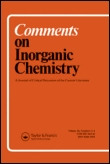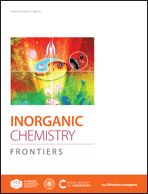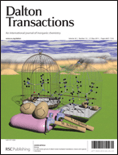
RUSSIAN JOURNAL OF INORGANIC CHEMISTRY
Scope & Guideline
Fostering Insights for a Sustainable Future
Introduction
Aims and Scopes
- Synthesis of Inorganic Compounds:
The journal publishes research on the development of new synthetic methods for inorganic compounds, including coordination complexes, metal-organic frameworks, and nanostructured materials. - Characterization Techniques:
Studies involving advanced characterization techniques such as X-ray diffraction, spectroscopy (NMR, IR, UV-Vis), and electron microscopy to analyze the structure, properties, and behavior of inorganic materials. - Thermodynamic Properties:
Research on the thermodynamic properties of inorganic compounds, including phase equilibria, solubility, and heat capacity studies, providing insights into their stability and reactivity. - Applications in Energy and Materials Science:
Exploration of the applications of inorganic materials in energy storage, catalysis, and environmental remediation, highlighting their potential for technological advancements. - Biological and Health-Related Applications:
Investigations into the biological interactions of inorganic compounds, including their potential use in medicinal chemistry and biocompatible materials.
Trending and Emerging
- Nanomaterials and Nanostructures:
A significant increase in research related to the synthesis, characterization, and application of nanomaterials, including metal nanoparticles and oxide nanostructures, highlighting their roles in catalysis and sensing. - Green Chemistry and Sustainable Practices:
Growing emphasis on environmentally friendly synthesis methods and the development of sustainable materials, reflecting a broader trend towards green chemistry in the scientific community. - Metal-Organic Frameworks (MOFs) and Porous Materials:
An upsurge in studies focused on the design and application of MOFs for gas storage, separation, and catalysis, showcasing their versatility and importance in contemporary materials science. - Biocompatible and Bioactive Inorganic Materials:
An increasing number of publications exploring the use of inorganic compounds in biomedical applications, particularly in drug delivery systems and biomaterials for tissue engineering. - Computational Chemistry and Modeling:
A rise in the use of computational approaches and simulations to predict the properties and behaviors of inorganic materials, enhancing the understanding of their structures and reactivity.
Declining or Waning
- Traditional Coordination Chemistry:
Research on classical coordination complexes has seen a reduction in interest, possibly due to the growing focus on more complex materials and applications in nanotechnology and catalysis. - Inorganic Solid-State Chemistry:
Although still relevant, the volume of papers dedicated to fundamental studies in solid-state chemistry, including crystal growth and phase transitions, has diminished as more interdisciplinary approaches gain popularity. - Synthesis of Simple Inorganic Salts:
The synthesis and characterization of simple inorganic salts, while important, are appearing less frequently as researchers pursue more complex and functional materials.
Similar Journals

Inorganics
Catalyzing Collaboration in Inorganic ResearchInorganics is a vibrant, peer-reviewed Open Access journal dedicated to advancing the field of inorganic chemistry, published by MDPI since 2013. Based in Switzerland, this journal aims to provide a dynamic platform for researchers, professionals, and students to share groundbreaking findings, fostering collaboration and innovation within the global scientific community. With an impressive Q2 ranking in the category of Inorganic Chemistry as of 2023, Inorganics stands out as a significant conduit for high-quality research that spans a wide range of topics from coordination compounds to metal-organic frameworks. Its commitment to accessibility ensures that cutting-edge research can be accessed, utilized, and built upon by a diverse audience, thereby amplifying its impact. Join the conversation in Inorganics and contribute to the ever-evolving landscape of inorganic chemical research.

Crystals is a premier open-access journal, published by MDPI since 2011, that focuses on the multidisciplinary fields of chemical engineering, condensed matter physics, inorganic chemistry, and materials science. With its E-ISSN 2073-4352, the journal is headquartered in Switzerland, and actively contributes to the global scientific community by facilitating the dissemination of high-quality research. Ranking in the Q2 quartile across multiple categories, including Chemical Engineering (miscellaneous) and Materials Science (miscellaneous) for 2023, Crystals provides a platform for innovative studies that span from fundamental research to practical applications. The journal's commitment to open access ensures that groundbreaking findings are readily available to researchers, professionals, and students alike, fostering an environment of collaboration and knowledge sharing that is essential in advancing the scientific understanding of crystalline materials.

COMMENTS ON INORGANIC CHEMISTRY
Bridging Theory and Practice in Inorganic ChemistryCOMMENTS ON INORGANIC CHEMISTRY is a prestigious academic journal published by Taylor & Francis Ltd, specializing in the dynamic field of inorganic chemistry. With an impressive impact factor placing it in the Q1 category, this journal ranks #6 out of 79 in its field, reflecting its high influence and contribution to the discipline, with a remarkable percentile ranking of 93rd. Since its inception in 1981 and spanning publications until 2024, this journal serves as a crucial platform for researchers, professionals, and students to disseminate groundbreaking findings, review articles, and discussions on contemporary topics in inorganic chemistry. Although it is not an Open Access journal, the rigorous peer-review process ensures the publication of high-quality research. By bridging theoretical and practical aspects of inorganic chemistry, COMMENTS ON INORGANIC CHEMISTRY remains an essential resource for advancing knowledge and fostering innovation within the scientific community.

Inorganic Chemistry Frontiers
Bridging Theory and Application in Inorganic ChemistryInorganic Chemistry Frontiers, published by the esteemed Royal Society of Chemistry, stands at the forefront of advancements in the field of inorganic chemistry, boasting a prestigious Q1 ranking in its category as of 2023 and an impressive Scopus Rank of #3 out of 79, placing it in the 96th percentile. Since its inception in 2014, this journal has provided a robust platform for high-quality research that spans the diverse and rapidly evolving areas of inorganic chemistry. As an open-access journal, it ensures that the findings presented are readily accessible to researchers, educators, and practitioners globally, fostering an inclusive environment for the dissemination of knowledge. With its rigorous peer-review process, Inorganic Chemistry Frontiers aims to facilitate interdisciplinary dialogue and innovation, making it an essential resource for anyone dedicated to exploring the myriad applications and theoretical advancements within inorganic chemistry.

JOURNAL OF THE INDIAN CHEMICAL SOCIETY
Fostering Innovation in Diverse Chemical DisciplinesJournal of the Indian Chemical Society, published by Elsevier, stands as a cornerstone in the field of chemistry, particularly representing the rich chemical research emanating from India.
With a significant history dating back to its establishment, this journal encompasses diverse disciplines including Drug Discovery, Electrochemistry, Inorganic Chemistry, Organic Chemistry, and Physical and Theoretical Chemistry, reflecting the evolving landscape of chemical sciences.
Despite being positioned in the Q3 category across multiple quarters, the journal demonstrates promising rankings in various chemistries, highlighting its commitment to advancing the knowledge and application of chemical sciences. While currently not available as an open access journal, the Journal of the Indian Chemical Society is dedicated to providing a platform for high-quality research that fosters innovation and collaboration among researchers, professionals, and students worldwide.
With its continuous publication from 1973 to the present, it serves as an essential repository for cutting-edge findings and developments in chemistry, striving to connect academia with industry and practice.

DALTON TRANSACTIONS
Catalyzing Collaboration in Chemical ResearchDALTON TRANSACTIONS, published by the esteemed Royal Society of Chemistry, is a premier journal in the field of Inorganic Chemistry, recognized for its significant contributions to advancing research and scholarship since its inception in 2002. With an impressive Impact Factor and ranked in the Q1 category, it holds a notable position at Rank #21 out of 79 within its Scopus category, highlighting its reputation for excellence and influence in the scientific community. This journal provides a platform for disseminating high-quality research, reviews, and communications related to all aspects of inorganic chemistry, fostering collaboration and innovation among researchers, professionals, and students alike. Although it does not offer open access, its robust selection process and commitment to scholarly integrity ensure that published works are of the highest standard. For those passionate about inorganic chemistry, DALTON TRANSACTIONS serves as an essential resource, fostering a deeper understanding of the field and its applications.

CRYSTENGCOMM
Illuminating the path of crystallization advancements since 1999.CRYSTENGCOMM is a distinguished journal published by the Royal Society of Chemistry, dedicated to advancing the field of crystallization and crystal engineering. With its impact factor consistently among the top tier in its category, CRYSTENGCOMM serves as an essential platform for researchers, professionals, and students in Chemistry, Condensed Matter Physics, and Materials Science. The journal has successfully maintained its relevance and influence since its inception, showcasing pioneering research from 1999 to 2024, with a commendable Q2 ranking in the latest evaluations. This accessibility to crucial developments in crystallization facilitates knowledge transfer across disciplines and enhances collaboration within the scientific community. Although it operates under a subscription model, the journal remains committed to disseminating cutting-edge research and fostering innovation in the field. For more information or to submit your research, please visit the Royal Society of Chemistry's website.

REVIEWS IN INORGANIC CHEMISTRY
Your Essential Resource for Inorganic AdvancementsREVIEWS IN INORGANIC CHEMISTRY, published by Walter de Gruyter GmbH, is a distinguished academic journal that serves as a vital resource for researchers, professionals, and students within the field of inorganic chemistry. With its ISSN 0193-4929 and E-ISSN 2191-0227, this journal has made a significant impact on the discipline, holding a commendable Q2 ranking in the 2023 category of Inorganic Chemistry, placing it in the 81st percentile among its peers according to Scopus rankings. Continuously published since its inception, with converged years spanning from 1985 to 1990 and 1992 to 2024, it features comprehensive reviews encompassing the latest advancements, methodologies, and theoretical frameworks in the subject. Researchers will find IDEAL insights and valuable discussions that keep them abreast of trends and challenges in the domain, essential for driving innovation and collaboration. The journal’s commitment to quality and rigorous peer review highlights its importance in advancing inorganic chemistry research, making it an indispensable tool for academic excellence.

MAIN GROUP METAL CHEMISTRY
Innovating Materials Science through Metal ChemistryMAIN GROUP METAL CHEMISTRY, published by De Gruyter Poland Sp. z o. o., is an esteemed open access journal that has made a significant impact in the fields of Chemistry, Condensed Matter Physics, and Materials Science since its inception in 1988. With its ongoing publication aimed at advancing scholarly discourse until 2024, this journal is indexed in leading databases and has earned a diverse readership due to its rigorous peer-review process and relevant contribution to the understanding of metal chemistry. In the 2023 category quartiles, it has been recognized as Q2 in Metals and Alloys and holds Q3 rankings in Chemistry (miscellaneous), Condensed Matter Physics, and Materials Chemistry, showcasing its interdisciplinary appeal and recognition in the scientific community. The journal's innovative open access model, implemented in 2019, enhances visibility and accessibility for researchers worldwide, fostering collaboration and discovery among professionals, students, and academics alike. By presenting high-quality research and critical reviews, MAIN GROUP METAL CHEMISTRY serves as a vital resource for those seeking to deepen their understanding of metal interactions and their applications in advanced materials.

Inorganic Materials-Applied Research
Bridging Disciplines Through Inorganic InsightsInorganic Materials-Applied Research is a pivotal journal dedicated to the dissemination of innovative research in the field of inorganic materials. Published by SpringerNature, this journal operates as a vital resource for researchers, professionals, and students alike, providing a platform for cutting-edge findings and methodologies related to the synthesis, characterization, and application of inorganic materials. With an ISSN of 2075-1133 and an E-ISSN of 2075-115X, the journal strives to bridge gaps in interdisciplinary studies, fostering collaboration across the engineering and materials science domains. Despite its current rankings placing it in the Q3 quartile for both Engineering and Materials Science categories, the journal aims for broader impact, seeking to enhance its visibility and contribution in publications through rigorous peer-review and open access options. Converged from 2010 to 2024, it remains committed to advancing knowledge and addressing contemporary challenges in materials science, thereby attracting contributions that are not only academically rigorous but also socially impactful.